
About a month ago, I bought some cornflakes from my corner store.
I noticed they were really yummy, full of dried berries inside.
I was quite happy with my purchase and placed it on top of my refrigerator to admire.
What I didn’t notice however, until a friend pointed it out, was that my Kellog’s cereal box had a giant sticker on it, covering up a bikini clad woman with a figure dressed in jeans.

original:

Inside the copy of an Economist I bought at a Tehran bookshop (for $4.50, not bad) a glossy red sticker blocked out the photo of a woman breast feeding. On a couple other pages you could find squiggly markings crossing out parts of pictures. Most foreign magazines I have found include genres of Home, Living, Food, Gardening, etc. When I saw an actual “Elle” magazine for sale in a shop window, I jumped, only to realize it was “Elle: Home and Garden.”
I found this good collection of some examples of this kind of magazine censorship:
(http://jturn.qem.se/2006/more-pictures-of-iranian-censorship/)




The few fashion magazines available are thoroughly inked through--shoulders, cleavage and knees seem to be considered the most sensitive zones. It reminds me of when I used to doodle in mags as a young teenager (a lot of things here somehow remind me of my teenage years, for example going to “illegal” parties).





This sign in front of the massage chair store has been censored, the knee proved too provocative:
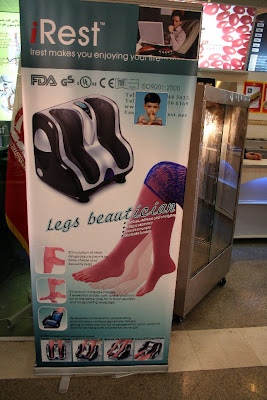
In clothing store windows, mannequins are strangely disfigured. The tops of heads are cut off and arms are often missing in effort to make the thing look less human as possible. Breasts are hacked off. Then, sometimes you can find one with a bandage on its little plastic nose, in imitation of the upper-class person who might be wearing such an attractive outfit, one who can afford a nose job. The poor mannequins really go through a lot.

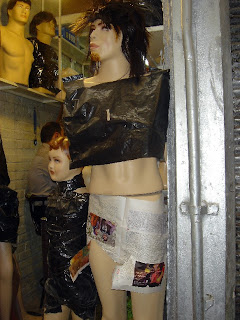
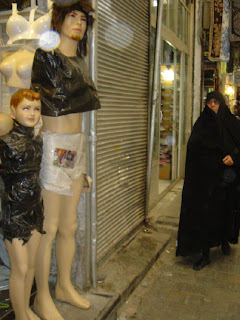
For films, the censorship methods are much more advanced and nuanced. Thus, a variety of foreign films, especially from Hollywood, are officially available, censored and dubbed in Persian. Sometimes you can’t even tell when a scene has been cut, or that they have painted the arms and legs of a sexy screen siren, such as Angelina Jolie, to make her more conservatively dressed--something you might not be able to tell unless viewed side by side. A 10 minute scene can take up to 3 days to work in editing, slowly molding it to fit the Islamic consumer’s taste and acceptance. Often the entire story must be changed, for example in Intolerable Cruelty, the wife could not be shown having an illicit affair with a strange man, so it was told that she was in the room with her brother.
Original Movie Poster:
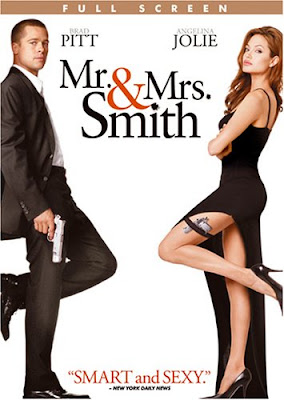
Iranian Version:
"Agha va Khanum Esmeeth" :)
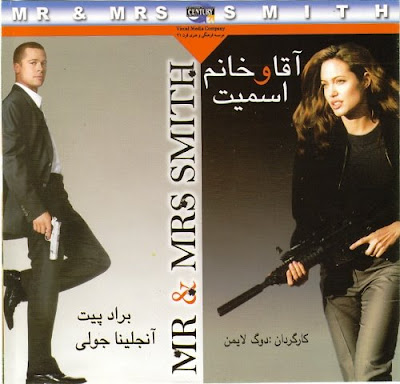
Some stills from censored version
Very often they cut out entire scenes, but in several they tediously paint on
this black t-shirt for the entire scene:

Zoomed in to hide the legs:

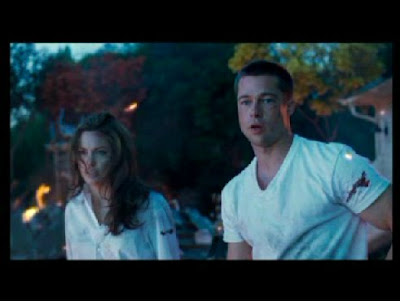
Painted Knees:
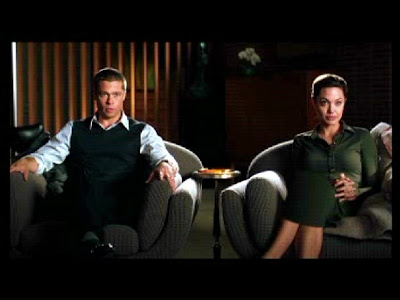

Black T-shirt again
In the unofficial world (which is a big one here), they say you can find everything. For example, the film Persepolis, based on the comic memoirs by Marjane Satrapi--the film is vehemently banned here for its so called negative portrayal of a sensitive and controversial period in the history of the Islamic Republic. It’s perhaps not as easy to find as others, given the higher risk if one gets caught with it.
From www.aref-adib.com:
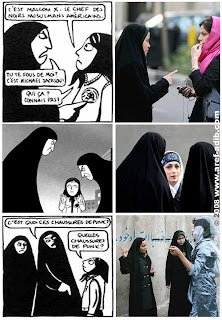
Another film proving controversial these days is the new film by Dariush Mehrjui—Ali Santuri, a pop-film about a Santur player who gets addicted to heroin. The film was allowed to be made, but once completed its release was banned, also quite sternly. The general message of the film seems to be that the society, its tough conditions (and perhaps the government) is at fault for Santuri’s addiction. Mr. Santuri the druggie is the hero, whose rich father saves him at the end by checking him in to a fancy hospital. People either hate it (to the point of theoretically spitting on it), or really like it and think it’s a very important film...It’s caused quite a stir that’s for sure. .

In a taxi cab, two passengers were chatting about it. The cabbie, cigarette dangling from his mouth, broke into the conversation with a very serious air:
“Do you know what the problem was with that film?”
The girl in the front seat was quiet. I could see her lips in the car’s side mirror, they were painted pink and pointed at the top. He asked again with a look of disbelief...
“So you don’t have any answers, huh?”
She shrugged, thinking.
With continued thoughtfulness he replied to himself, “The problem with that film is Golshifteh (the name of the actress).”
Slightly relieved she said, “Oh you mean she wasn’t suitable for the role?”
He went on, energized, “Mahnaz (another actress) was made for that role, that was her role! Golshifteh’s body type, her size, age, character, just didn’t fit that role…like in that scene when…”
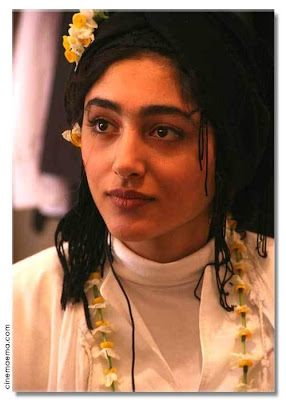

Golshifteh v. Mahnaz
The girl lowered her face, and I met her eyes in the mirror. She wiped her lips together trying hard not to break into laughter.
I hear many people speaking about it on the streets, they seem to like it. My question is, does banning it make it even more popular? The director has actually set up an account, asking for people’s donations if they buy it on the black market. He has collected 11,000,000 tomans so far ($11,000), in the matter of weeks. Interestingly, Mehrjui has been known to steal stories and music for his films, possible in a country with no copyright, where everything is found on the black market (the cruel society he made his film in).
Even the flashy advertisement at the beginning of an Iranian DVD, telling you not to copy this film for commercial purposes, is stolen. The name of the main Iranian distributor is 'Century 21 Visual Media Co', mysteriously similar to '20th Century Fox'.
Iranian Art-house films have been hailed by International film communities for the way they curb the censors so poetically and melancholic, making them stylish and exotic.
I'd imagine the worst to get caught with would be porn, which is also available in the black markets. Although I heard a story about a guy who got away with it: When caught with many Gigabytes of the stuff, his excuse was that better he get it out of his system at home in private, rather than in the streets, with a real woman.
As for music, some foreign stuff, mostly classical or instrumental, gets through the Ministry of Culture’s examination process. They do sell the Buddha Bar compilations, as well as David Gilmore, Black Sabbath, Metallica and Alice Cooper officially. Underground Iranian bands play a variety of genres from dark metal to vulgar hip hop or political jazz fusions. Solo women singers cannot record albums, and are only allowed to sing to an all woman audience. Although one woman has recorded her album inside the Italian Embassy: (http://www.wnyc.org/shows/soundcheck/episodes/2008/01/30)
Unfortunately Celine Dion is also very popular, unofficially that is, probably thanks to the immense popularity of Titanic. And a great place to hear other popular music (official and unofficial) is, of course, the infamous taxi cab, where they often like to blast it at max volume.
You could say alcohol consumption is censored. That is, it is technically illegal (except for Christians and Jews), though many normal households carry it in some form. For others there are plenty of non-alcoholic beers and look-alike 'bars' which serve them. For the real stuff, the pharmacy is the nearest equivalent of a liquor store, and with it come the experts on which types of pure alcohol are best—the main criteria being taste, smell and headache. Otherwise, Aragh Sagi (‘dog’s liquor’), Armenian homemade raisin vodka, is the most popular, and one can find a wide assortment of other hard beverages. All sorts of alcohol paraphernalia are also openly available in shops and bazaars: shot glasses, whiskey and wine glasses, wine carafes, bottle openers...
Women’s heads are censored. They also tried to censor their backsides, but it’s just proven to be impossible.
The internet is censored in various fashions. Firstly, It is very difficult to get high-speed internet, even though there are giant billboards advertising it all over the city. And even if you get it (most neighborhoods only offer DSL to businesses) it’s still not that fast-- max 256K DSL. Dial-up creates major limits, especially as more and more sites are becoming multi-media oriented, with photos, graphic, music, or video clips.
Various websites are blocked, for example sites like Facebook, MySpace, Flickr and Youtube, likely due to their networking capabilities. Foreign media is mostly available, while those written in Persian are considered more of a threat, for example BBC Persian or Rooz Online and various Iranian bloggers’ sites. Also various Iranian Society and Culture sites such as “The Iranian” are blocked. Various naughty words found in Google searches also block you reaching a page. People find ways around it however, with a filter remover program, although they make the connection even slower.
Babelfish, the translation site is also blocked, for some reason, I can't figure out why?

Internet cafes, or 'Coffee Nets', are another option for high-speed internet, although I don’t know many people who use them, and haven’t seen too many around town. You hear about them getting shut-down often, for various technicality excuses. Students probably get decent, though limited, access in their Universities. It seems a best option is to use your internet at work, which is what many people I know do.
As often reported in western media, various newspapers and journals with liberal/reformist opinions get shutdown. Some of them go online. There are still a few remaining that intellectuals trust to some extent.
In Tehran’s Contemporary Art Museum, an impressive collection of modern art is hidden in storage ( http://www.guardian.co.uk/world/2007/oct/29/artnews.iran).
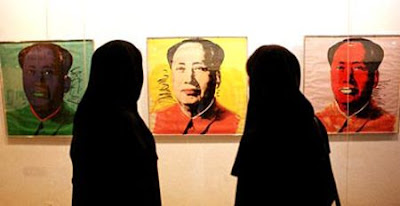
Bookshops + Café combos are seen as danger zones, recently a popular one downtown was closed. I was lucky enough to visit it right when I arrived. Several books were not allowed reprint this year, including translations of best selling Da Vinci Code (for upsetting Christian clerics) and The Girl with a Pearl Earring, along with several Iranian books. http://www.guardian.co.uk/world/2006/nov/17/books.iran Authors as well as musicians are turning to the internet more and more to get their work published.
There is a Wikipedia entry called “Censorship in Iran.”
Even the mountains and blue sky surrounding Tehran are sometimes censored, by clouds of dust. The dust comes from the happy farting of millions of cars, but also perhaps from 30 years of bulldozed buildings and demolished memories. Neverending nostalgia-dust.
The interesting thing, I find, is that a lot of the censorship here is not really hidden, whether it’s on movies, the internet, or women. It’s just there, an institution normalized in the everyday of society, a marker’s scribble in a glossy magazine, a big sticker, a camera zoom hiding some cleavage, or a mannequin with holes for breasts.
In some sense, you could say that the negotiations and associations with censorship in Iran are sexy, leaving the mark of a mysterious hole to fill with imaginations. What is outlawed becomes so much more desirable. In another sense, it feels like a strange incurable sickness.
It also says, look we can have both: the shiny objects of desire from the modern world and the Islamic principles of our world, however twisted it all may turn out.




























